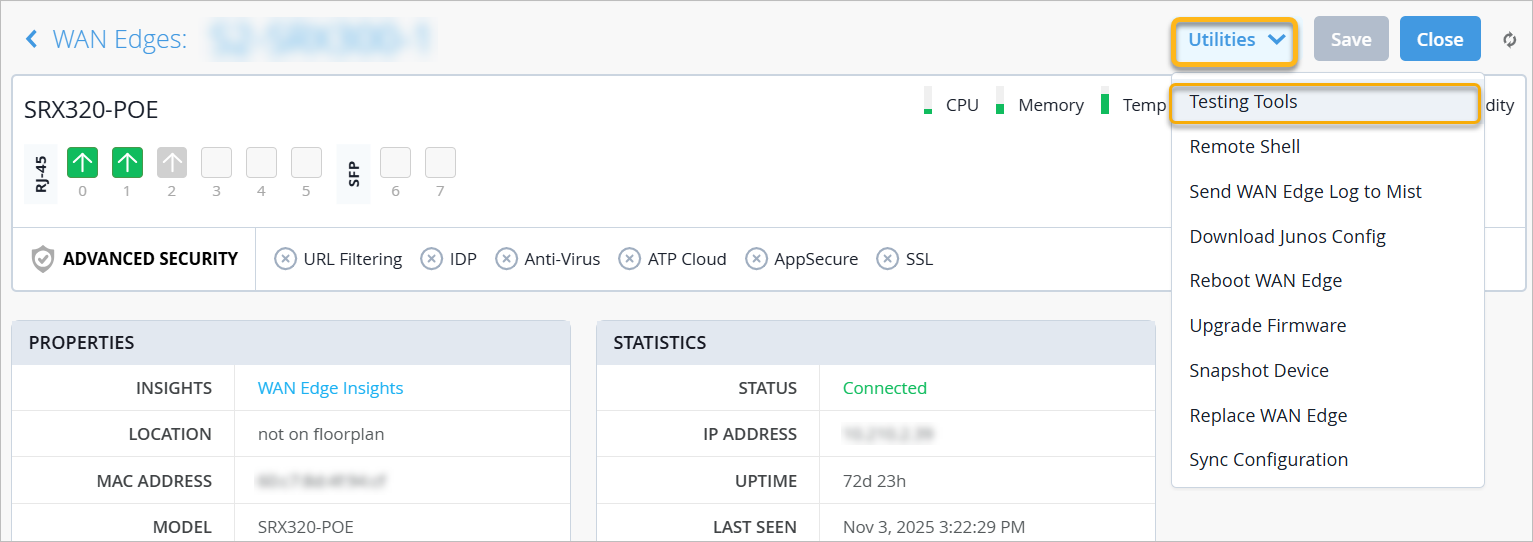ON THIS PAGE
WAN Edge Testing Tools
Follow these steps to add Juniper Mist™ testing tools to your troubleshooting process.
The Juniper Mist portal provides testing tools that play crucial roles in maintaining network health and diagnosing issues. You can use the tools to:
- Identify network bottlenecks, latency, and packet loss.
- Check connectivity and measuring round-trip time.
- Identify the path taken by network traffic from source to destination for a specific application.
- Monitor BGP peering status and troubleshoot connectivity issues.
To use WAN Edge testing tools:
Finding the WAN Edge Testing Tools
After you've selected a WAN Edge device on the WAN Edges page, you'll find Testing Tools in the Utilties menu.

Testing Tools
On the WAN Edge Testing Tools page, use the buttons and tabs to select a testing tool. The buttons represent testing categories, and the tabs represent specific testing tools.
| Category (button) | Tool (tab) | Description |
|---|---|---|
| Applications (SSR Only | Path | Enter the application name, and then click Show Path. You'll see details for each path. |
| Sessions | See the path information for a specific application. You can also delete sessions. Deleting a session might be useful in situations where a stuck session was created and traffic is not sending due to upstream problems. Enter the application name, and then click Show Sessions. You'll see details for each session. To delete sessions:
|
|
| ARP (SSR Only) | Refresh ARP |
During troubleshooting scenarios, remove Address Resolution Protocol (ARP) entries from the WAN Edge device or the node's ARP cache. Enter the port name (required) and other details (optional), and then click Refresh ARP. By using the optional details, you specify which entries to remove. |
| Table | Click Show ARP to see all interface details including current state. | |
| BGP | Clear BGP |
Clear sessions with all BGP neighbors or with specific BGP peer. Enter the neighbor ID (required) and other details (optional), and then click Clear BGP. |
| Advertised Routes |
Display all routes that have been advertised to the specified neighbor. Enter a neighbor IP (required) and VRF (optional). Click Show Routes. You'll see the routes that your device has advertised to the peer router during the current BGP session. |
|
| Received Routes |
See the routes that your device has advertised to the peer router during the current BGP session. Enter a neighbor IP (required) and VRF (optional). Click Show Routes. You'll see the routing information as it was received through the specified neighbor. |
|
| Routes |
Debug the BGP routing table. Click Show Routes. Optionally, you can specify a prefix and VRF to narrow down the list of routes. You'll see how the sent or received prefixes from various neighbors are being handled and processed in the BGP table. |
|
| Summary | Click Show Summary. You'll see details for all BGP entries. | |
| FIB (SSR Only) | FIB Lookup |
View the forwarding information base (FIB) data associated with the WAN Edge device. Enter the network, IP, protocol (all required) and destination port (optional). Then click Show FIB. You'll see information for each FIB. |
| FIB By Application | Enter the application (required) and other optional information. . Then click
Show FIB. You'll see information for each application. |
|
| OSPF | Database | Click Show Database. Optionally, to narrow down the
results, first select a Self Originate option and enter a VRF. You'll see area, LSA, and routingdetails for each VRF. |
| Interfaces | Click Show Interfaces. Optionally, to narrow down the
results, first enter a VRF. You'll see interface details for each VRF. |
|
| Neighbors | Click Show Neighbors. Optionally, to narrow down the
results, first enter IP, interface, or VRF. You'll see neighbor information for each VRF. |
|
| Routes | Click Show Routes. Optionally, to narrow down the
results, enter a route prefix or VRF. You'll see route details for each VRF. |
|
| Summary | Click Show Summary. Optionally, to narrow down the
results, enter a VRF. You'll see area details for each VRF. |
|
| Utility | Bounce Port |
Provisionally take down the port and bring it up without causing the external physical link to change. The connected devices will not see a link state change. Enter the port, and then click Soft Bounce Port. |
| Ping |
Use the Ping tool to send Internet Control Message Protocol (ICMP) echo requests to a specified host. You can use this command to check if a particular host is reachable at a particular IP address. Enter the IP address and the port name. Click Ping. Optionally, you can specify the count (the number of requests to send, 1-100) or the ping packet size in bytes (64-65,535. |
|
| Show FIB (SRX Only) | ||
| Traceroute |
Traceroute is a network diagnostic tool that traces an IP packet's path to a host, revealing the sequence of routers (hops) it takes along the way. Enter a host, and then click Traceroute. Optionally, also enter a network. |
|
| WAN DHCP Release (SSR Only) |
Release client devices from their current DHCP lease. Enter the port name, and then click Release. |
